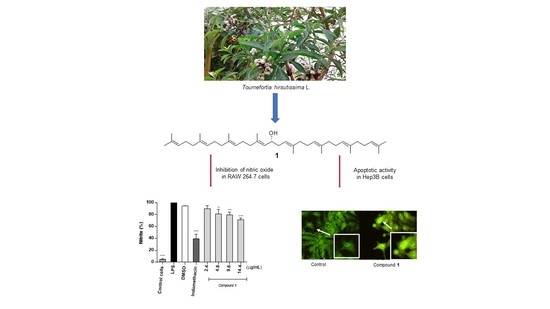https://www.mdpi.com/1420-3049/24/13/2366
1
Centro de Investigaciones Químicas-IICBA, Universidad Autónoma del Estado de Morelos, Cuernavaca 62209, Morelos, Mexico
2
Facultad de Farmacia, Universidad Autónoma del Estado de Morelos, Cuernavaca 62209, Morelos, Mexico
3
Centro de Investigación Biomédica del Sur, Instituto Mexicano del Seguro Social, Xochitepec 62790, Morelos, Mexico
*
Author to whom correspondence should be addressed.
Academic Editors: Ewa Swiezewska and Liliana Surmacz
Molecules 2019, 24(13), 2366; https://doi.org/10.3390/molecules24132366
Received: 13 June 2019 / Revised: 24 June 2019 / Accepted: 24 June 2019 / Published: 26 June 2019
(This article belongs to the Special Issue Plant Isoprenoids)
Abstract
Three polyisoprenoid alcohols were isolated from the leaves of Tournefortia hirsutissima by a bioassay-guided phytochemical investigation. The compounds were identified as 16-hydroxy-lycopersene (Compound 1), (Z8,E3,ω)-dodecaprenol (Compound 2) and (Z9,E3,ω)-tridecaprenol (Compound 3). Compound 1, an unusual polyisoprenoid, was characterized by 1D and 2D NMR. We also determined the absolute configuration at C-16 by the modified Mosher’s method. The in vitro antiproliferative and anti-inflammatory activities of the isolated compounds were evaluated. Among isolates, Compound 1moderately inhibited the nitric oxide production in lipopolysaccharide (LPS)-stimulated RAW 264.7 cells. On the other hand, Compound 1 displayed selective antiproliferative activity against HeLa, PC3, HepG2 and Hep3B cancer cells and was less potent against IHH non-cancerous cells. Compound 1 in Hep3B cells showed significant inhibition of cell cycle progression increasing the sub-G1 phase, suggesting cell death. Acridine orange/ethidium bromide staining and Annexin V-FITC/PI staining demonstrated that cell death induced by Compound 1 in cells Hep3B was by apoptosis. Further study showed that apoptosis induced by Compound 1 in Hep3b cells is associated with the increase of the ratio of Bax/Bcl-2, and caspase 3/7 activation. These results suggest that Compound 1 induce apoptotic cell death by the mitochondrial pathway. To our knowledge, this is the first report about the presence of polyprenol Compounds 1–3 in T. hirsutissima, and the apoptotic and anti-inflammatory action of Compound 1. View Full-Text
Keywords: 16-hydroxy-lycopersene; polyisoprenoid alcohols; Tournefortia hirsutissima; anti-inflammatory activity; apoptosis
▼ Figures
This is an open access article distributed under the Creative Commons Attribution License which permits unrestricted use, distribution, and reproduction in any medium, provided the original work is properly cited (CC BY 4.0).

Share & Cite This Article
MDPI and ACS Style
Hurtado-Díaz, I.; Sánchez-Carranza, J.N.; Romero-Estrada, A.; González-Maya, L.; González-Christen, J.; Herrera-Ruiz, M.; Alvarez, L. 16-Hydroxy-Lycopersene, a Polyisoprenoid Alcohol Isolated from Tournefortia hirsutissima, Inhibits Nitric Oxide Production in RAW 264.7 Cells and Induces Apoptosis in Hep3B Cells. Molecules 2019, 24, 2366.
Note that from the first issue of 2016, MDPI journals use article numbers instead of page numbers. See further details here.

